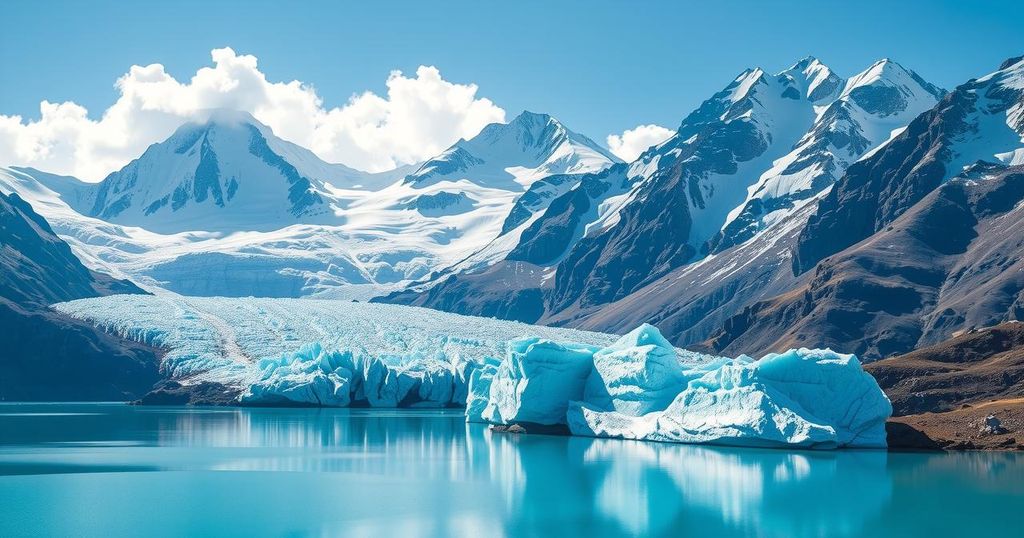Nepal’s Sagarmatha Sambaad: Tackling Climate Change While Harnessing Glacial Resources

The Sagarmatha Sambaad, starting today in Kathmandu, aims to address climate change and the importance of the Himalayas. The summit will emphasize ecological preservation over revenue, focusing on the rapid retreat of glaciers and their implications. Despite the hazards, glaciers also represent untapped economic resources for water, tourism, and cultural significance.
Today marks the opening of the inaugural Sagarmatha Sambaad in Kathmandu, a significant dialogue forum led by Nepal’s Foreign Ministry. Spanning three days, the summit will delve into pressing global issues, particularly climate change and the future of our mountains. It’s worth considering how this initiative could redefine the relationship with the Himalayas, potentially lifting the focus from just revenue generation to a broader understanding of ecological preservation.
The Himalayas house the world’s largest ice reserves outside of the polar regions. Over a billion individuals in regions like the Brahmaputra, Ganges, and Indus rivers depend on this ice for drinking water, irrigation, and hydroelectric power. But these glaciers are rapidly retreating, with average temperatures in the Nepalese Himalayas climbing 0.06℃ per year—a rate that surpasses the global average. This alarming trend has resulted in increased glacial lake sizes and a rise in hazardous events such as glacial lake outburst floods (GLOFs). The impact extends beyond water supply; the reliability of river flows during the rainy season and droughts has been severely affected, causing devastating consequences for surrounding communities.
The situation continues to deteriorate as Nepal grapples with accelerated glacier recession. Between 1977 and 2010, the country saw a 24% reduction in glacier area and a staggering 29% loss in ice reserves. Interestingly, the number of glaciers increased from 3,429 to 3,808 during this time due to fragmentation. This translates to a loss of approximately 38 square kilometers of glacier area annually, driven by rising temperatures and diminishing precipitation. Iconic glaciers such as Yala in the Langtang region may vanish entirely by 2040 without effective intervention.
Nepal is home to over 2,000 glacial lakes, which have been expanding at an average rate of 0.83% per year. Recent studies conducted by ICIMOD and UNDP identified 3,579 such lakes and noted 21 that pose significant risks for GLOFs. Notably, lakes located near the border with China also present threats; these could cause colossal floods, inflicting destruction deeper into Nepal’s infrastructure, damaging buildings, bridges, and hydropower facilities.
Yet, it is crucial to acknowledge that glaciers and glacial lakes are not solely markers of climate change or hazards. They represent untapped economic resources. The glaciers and their lakes can serve as crucial water supplies for irrigation and hydroelectric generation at a time when freshwater is becoming scarce. They also have immense cultural significance, acting as pilgrimage sites for Hindus and Buddhists. Furthermore, the picturesque landscapes call to adventure seekers, offering thrilling opportunities for winter sports that remain underdeveloped in the region.
The Sagarmatha Sambaad should aim to direct efforts towards monitoring the cryosphere, developing risk management strategies, and promoting sustainable development. There is potential for using remote sensing technologies and creating databases to monitor glacier dynamics. This data would be invaluable for generating early warning systems to preempt floods and avalanches. Additionally, interdisciplinary collaboration for implementing effective engineering measures could further mitigate risks.
In conclusion, through the Sagarmatha Sambaad, Nepal has a pivotal opportunity to advocate for climate justice while promoting its glaciers and glacial lakes as vital resources. By ensuring a balance between environmental sustainability and economic opportunity, Nepal can advance towards a resilient future for its communities dependent on these precious cryospheric resources.
The Sagarmatha Sambaad provides Nepal with a vital platform to address the intricate challenges posed by climate change while also leveraging its unique glaciers and glacial lakes. These natural resources hold profound ecological and economic potential that, if harnessed responsibly, can support local communities and foster sustainable development. Promoting technological collaboration and effective early warning systems will be essential to mitigate risks associated with melting glaciers and enhance the resilience of mountain populations.
Original Source: myrepublica.nagariknetwork.com






